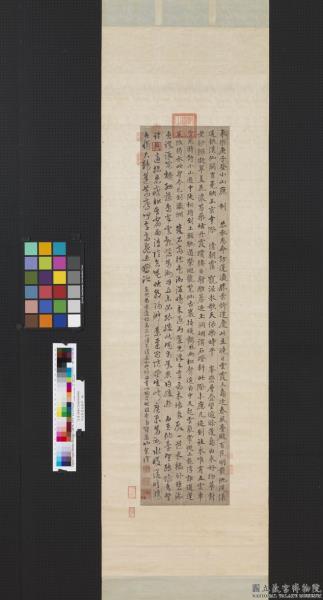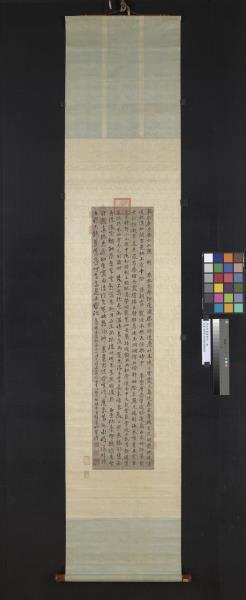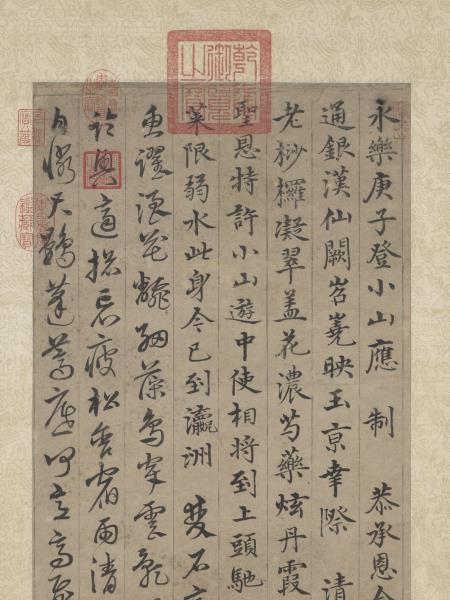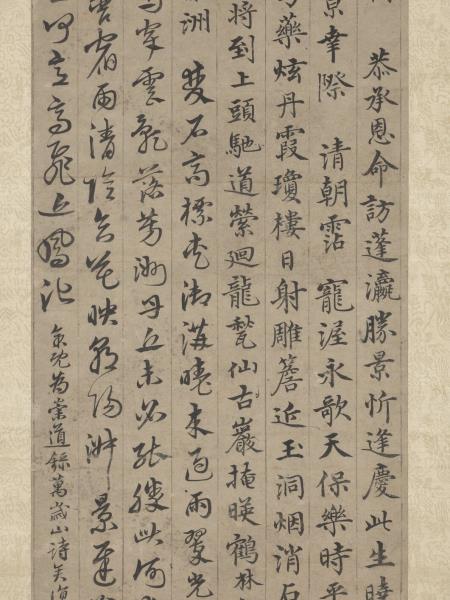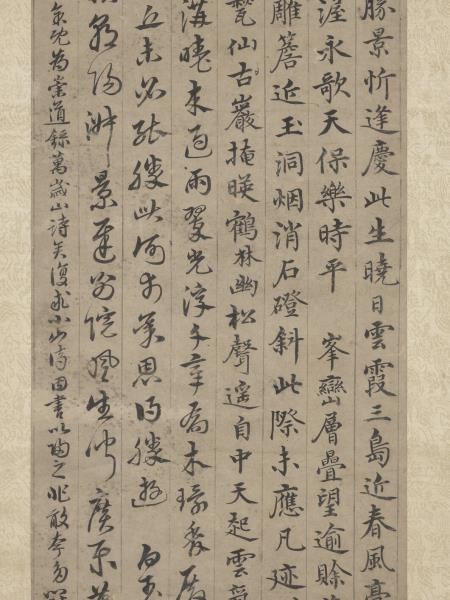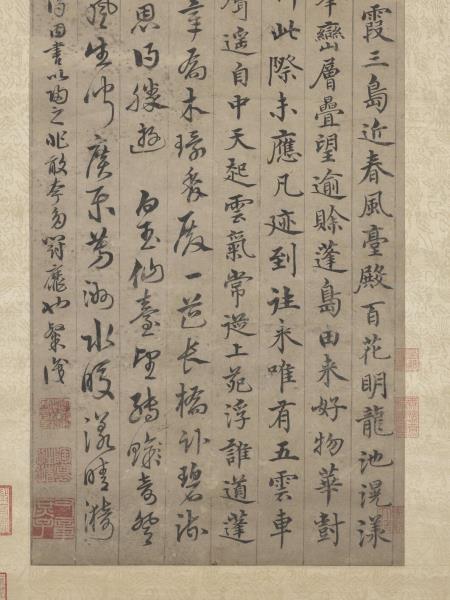明沈粲書應制詩 軸
Poetry Written on Imperial Command
法書
永樂庚子登小山應制。恭承恩命訪蓬瀛。勝景忻逢慶此生。曉日雲霞三島近。春風臺殿百花明。龍池滉漾通銀漢。仙闕岧嶢映玉京。幸際清朝霑寵渥。永歌天保樂時平。峰巒層疊望逾賒。蓬島由來好物華。樹老桫欏凝翠蓋。花濃芍藥炫丹霞。瓊樓日射雕簷近。玉洞烟消石磴斜。此際未應凡迹到。往來唯有五雲車。聖恩特許小山遊。中使相將到上頭。馳道縈迴龍甃仙。古巖掩暎鶴林幽。松聲遙自中天起。雲氣常從上苑浮。誰道蓬萊限弱水。此身今已到瀛洲。雙石高標夾御溝。曉來過雨翠光浮。千章喬木環香殿。一道長橋臥碧流。魚躍浪花飜細藻。鳥穿雲影落芳洲。丹丘未必能勝此。何幸承恩得勝遊。白玉仙臺望轉(賒字點去)奇。登臨興適總忘疲。松含宿雨清陰合。花映朝陽淑景遲。別院風生聞廣樂。芳洲水暖漾晴漪。自憐尺鷃蓬蒿底。何意高飛近鳳池。余既為崇道錄萬歲山詩矣。復求小山詩。因書以歸之。非敢夸多鬪靡也。粲識。
| 文物統一編號 | 故書000013N000000000 |
| 作品號 | 故書00001300000 |
| 品名 |
明沈粲書應制詩 軸 Poetry Written on Imperial Command |
| 分類 | 法書 |
| 作者 | 沈粲,Shen Can |
| 書體 | 楷書 |
| 數量 | 一軸 |
| 作品語文 | 漢文 |
| 釋文 | 永樂庚子登小山應制。恭承恩命訪蓬瀛。勝景忻逢慶此生。曉日雲霞三島近。春風臺殿百花明。龍池滉漾通銀漢。仙闕岧嶢映玉京。幸際清朝霑寵渥。永歌天保樂時平。峰巒層疊望逾賒。蓬島由來好物華。樹老桫欏凝翠蓋。花濃芍藥炫丹霞。瓊樓日射雕簷近。玉洞烟消石磴斜。此際未應凡迹到。往來唯有五雲車。聖恩特許小山遊。中使相將到上頭。馳道縈迴龍甃仙。古巖掩暎鶴林幽。松聲遙自中天起。雲氣常從上苑浮。誰道蓬萊限弱水。此身今已到瀛洲。雙石高標夾御溝。曉來過雨翠光浮。千章喬木環香殿。一道長橋臥碧流。魚躍浪花飜細藻。鳥穿雲影落芳洲。丹丘未必能勝此。何幸承恩得勝遊。白玉仙臺望轉(賒字點去)奇。登臨興適總忘疲。松含宿雨清陰合。花映朝陽淑景遲。別院風生聞廣樂。芳洲水暖漾晴漪。自憐尺鷃蓬蒿底。何意高飛近鳳池。余既為崇道錄萬歲山詩矣。復求小山詩。因書以歸之。非敢夸多鬪靡也。粲識。 |
| 位置 | 尺寸(公分) |
|---|---|
| 本幅 | 121.7x28.7 |
| 質地位置 | 質地 |
|---|---|
| 本幅 | 紙 |
| 印記類別 | 印主 | 印記 |
|---|---|---|
| 作者印記 | 沈粲 | 又章庶子 |
| 作者印記 | 沈粲 | 東觀大隱 |
| 作者印記 | 沈粲 | 陶寫性情 |
| 作者印記 | 沈粲 | 雲間沈粲民望 |
| 作者印記 | 沈粲 | 簡菴 |
| 鑑藏寶璽 | 清內府印 | 石渠寶笈 |
| 鑑藏寶璽 | 宣統帝 | 宣統御覽之寶 |
| 鑑藏寶璽 | 宣統帝 | 宣統鑑賞 |
| 鑑藏寶璽 | 清高宗 | 乾隆御覽之寶 |
| 鑑藏寶璽 | 清高宗 | 御書房鑑藏寶 |
| 鑑藏寶璽 | 宣統帝 | 無逸齋精鑑璽 |
| 鑑藏寶璽 | 清仁宗 | 嘉慶御覽之寶 |
| 類別 | 參考資料 |
|---|---|
| 內容簡介 | 沈粲(西元一三七九-一四五三年),字民望,華亭(今上海)人。他與年長二十二歲的哥哥沈度,同樣以擅於書法在朝廷中享有名聲。 沈粲得到皇帝的恩准,遊覽宮苑,並以藻麗的詞句,歌頌皇家園林之美。此幅楷書與章草二體並用,楷書精整,草書則是將三世紀時古樸的書體化作華麗的,講究技巧的書法。末一行出現放縱的連筆草書,好像逐漸從拘謹的筆法中解脫出來。 |
| 內容簡介 | 沈粲(西元一三七九-一四五三年),字民望,華亭(今上海)人。與年長二十二歲的哥哥沈度並稱二沈,同樣以擅於書法在朝廷中享有名聲。粲擅長草書,學明初宋璲、宋克,參以鐘繇,行筆圓熟,意趣遒逸。 此幅內容是為友人書寫,描述皇室宮苑,贊頌皇家園林之七言律詩五首,這些由沈粲所作應制詩,沈氏講究地用行楷書、章草及今草三體書之,其中行楷書精整,章草古樸,今草則筆法放縱。 |
| 內容簡介 | 沈粲(西元一三七九-一四五三年),字民望,華亭(今上海)人。與年長二十二歲的胞兄沈度並稱二沈,以擅於書法在朝廷中任職。沈粲擅長草書,學明初宋璲、宋克,參以鍾繇,行筆圓熟,意趣遒逸。此幅內容是為友人書寫,描述皇室宮苑,贊頌皇家園林之七言律詩五首,以用行楷書、章草及今草三體書之,其中行楷書精整,章草古樸,今草則筆法放縱。(20110913) |
| Description | Shen Can (style name Minwang), a native of Huating (modern Shanghai), like his brother Shen Du (elder to him by 22 years), excelled at calligraphy and served the court. Shen Can excelled at cursive script, studying that of Song Sui and Song Ke of the early Ming and combining it with Zhong You’s, his brushwork being rounded and mature for an untrammeled manner. The contents of this work were done for a friend, describing the palace gardens and praising the beauty of the imperial park in five poems of seven-character verse. These were done in the imperially ordered style of poetry, Shen Can making an effort to use the three script types of semi-standard, draft cursive, and contemporary cursive, which here appear refined, archaic, and unbridled, respectively.(20110913) |
| Description | Shen Ts’an (style name Min-wang), a native of Hua-t’ing (modern Shanghai), achieved fame like his elder brother Shen Tu by 22 years for calligraphy at court. Shen Ts’an excelled at cursive script, studying that of Sung Sui and Sung K’o of the early Ming and combining it with Chung Yu’s, his brushwork rounded and mature for an untrammeled manner. The contents of this work were done for a friend, describing the palace gardens and praising the beauty of the imperial park in five poems of seven-character verse. These were done in the imperially ordered style of poetry, Shen Ts’an making effort to use the three script types of semi-standard, draft cursive, and modern cursive, which here appear refined, archaic, and indulgent, respectively. |
| Description | Shen Ts'an, a native of what is now Shanghai, achieved fame like his elder brother Shen Tu as a court calligrapher, and he also served as an official. The emperor bestowed on Shen Ts'an the honor of traveling through the imperial gardens, the beauty of which he praised in this work of poetry and calligraphy. This work was done in a combination of standard and draft-cursive scripts. His standard script is more precise and his cursive script is adorned with elements of the archaic and simple draft-cursive script of the 3rd-century as he focused on technique. Only the last line at the far left reveals unrestrained cursive script with interconnected strokes. Thus, at the end, he finally broke out completely from the confines of technique. |
| 收藏著錄 | 石渠寶笈初編(御書房),下冊,頁1095 |
| 收藏著錄 | 故宮書畫錄(卷二),第一冊,頁7 |
| 參考書目 | 1.朱惠良,〈明沈粲書應制詩〉,收入《雲間書派特展圖錄》(臺北:國立故宮博物院,1994年初版),頁120-121。 2.何傳馨,〈明沈粲應制詩〉,收入何傳馨編,《書法之美特展圖錄》(臺北:國立故宮博物院,1992年五月初版一刷),頁81-82。 |

